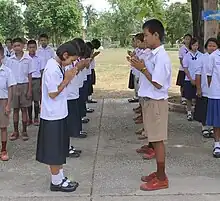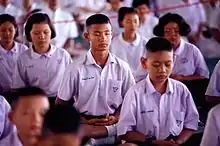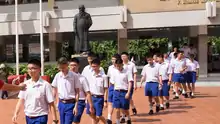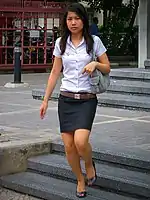The Thai school uniform is compulsory for students in Thai public and private school systems, not including a higher education institute which provides degree level education.[1] Few variations from the standard model are permitted, but schools are not restricted from adopting additional, non-standard uniforms.[2]
Public schools
| Boys | Girls | |
|---|---|---|
| Top | Shirts
Most male students wear a white shirt with a left breast pocket. Initials or logo on the left breast and the name of the school or student ID number on the right breast. Embroidery in red or blue. |
Blouses
|
| Bottom | Pants and belt
Three styles:
|
Skirt
|
| Shoes, Socks |
|
|
- Typical school uniforms
 Girl's and boys' school uniforms at Baan Hat Seua Ten School, Uttaradit
Girl's and boys' school uniforms at Baan Hat Seua Ten School, Uttaradit.jpg.webp) Girls' and boys' school uniform with black skirt and shorts
Girls' and boys' school uniform with black skirt and shorts Girl's uniform, taken at Wat Khung Taphao, Ban Khung Taphao
Girl's uniform, taken at Wat Khung Taphao, Ban Khung Taphao Uniform with name embed on the shirt
Uniform with name embed on the shirt Boy's uniform of Assumption College (Thailand) with dark blue shorts
Boy's uniform of Assumption College (Thailand) with dark blue shorts
University
University uniforms are generally standard throughout the country.[3] They typically consist of a white blouse and plain or pleated skirt for females, and long black trousers, a white long-sleeved shirt with a dark blue or black tie for males.[4] There are minor variations for Muslim or transgender students.[5][6][7] Thai university dress codes have been the subject of both controversy and satire.[8][9] Research has indicated that the wearing of uniforms reinforces in-group and out-group behaviours and existing hierarchies, but "does not promote students' life goals".[10]
- Typical university uniforms
 Female Chulalongkorn University uniform
Female Chulalongkorn University uniform.jpg.webp) Chulalongkorn students
Chulalongkorn students.jpg.webp) Chulalongkorn students wearing male university uniforms with former Prime Minister Abhisit Vejjajiva.
Chulalongkorn students wearing male university uniforms with former Prime Minister Abhisit Vejjajiva..jpg.webp) Chulalongkorn students
Chulalongkorn students
Controversy
On 1 December 2020, Thai school students, who have been helping to lead the pro-democracy protests, have refused to wear school uniforms on the first day of term, in a defiant protest to demand individual freedom over their lives and their bodies. They used the hashtag #1ธันวาบอกลาเครื่องแบบ (#1DecemberDownwiththeuniform) on Twitter, and invited every students to wear casual clothes instead. This gained many attractions from both the media, and the government. After a while in that day, the students in many schools; such as Horwang (หอวัง), Bodindecha (บดินทรเดชา) who wore such clothes were punished by their own teachers, with some exception occurred in Samsen Wittayalai School — one of Thailand's most selective schools — which have responded positively to the protest. Students posted photos and stories of how the school staff and director have stood in front of the gates to welcome students in casual wear to freely enter and learn inside their classrooms.[11][12]
Student communities began to question the necessity of the uniform, and seek the new solution towards their demand for reform of the country.
See also
References
- ↑ "Student Uniform Act, BE 2551 (2008)". Wikisource. Retrieved 8 January 2018.
- ↑ "School uses military uniforms to discipline kindergarteners". Pratchatai English. 2016-05-27. Retrieved 28 January 2018.
- ↑ Techawongtham, Wasant (8 February 2020). "A land being strangled by uniformity" (Opinion). Bangkok Post. Retrieved 8 February 2020.
- ↑ "Student Uniform Policy". Mahidol University International College. Retrieved 28 January 2018.
- ↑ "Student Uniforms". Prince of Songkla University. Retrieved 28 January 2018.
- ↑ Stout, David (2015-06-10). "A Thai University's New Dress Code Accommodates Transgender Students". Time. Retrieved 28 January 2018.
- ↑ Winn, Patrick (2015-06-16). "At this Thai school, transgender students now get uniforms of their own". Public Radio International (PRI). Retrieved 28 January 2018.
- ↑ Kaewmala (2013-09-22). "Top 10 reasons why Thai university students should wear uniforms". Asian Correspondent. Retrieved 28 January 2018.
- ↑ Farrell, James Austin (2013-04-12). "Uniforms might be bad for students, but they're good for something" (Opinion). Citylife Chiang Mai. Retrieved 28 January 2018.
- ↑ Bunyawanic, Sasanun; Järvelä, Maria-Liisa; Ghaffar, Abdul (July 2018). "The Influence of Uniform in Establishing Unity, Hierarchy, and Conformity at Thai Universities". Journal of Education and Training Studies. 6 (7). Retrieved 8 February 2020.
- ↑ "[UPDATE] Students across Thailand dress casual in protest against school uniform regulations". Thai Enquirer. 2020-12-01. Retrieved 2020-12-02.
- ↑ Meechukhun, Nop (2020-12-01). "Students across Thailand wear casual outfits to schools in protest against uniform regulations as a part of the pro-democracy movements". The Pattaya News. Retrieved 2020-12-02.
External links
- พระราชบัญญัติเครื่องแบบนักเรียน พุทธศักราช 2482 จากเว็บไซต์ราชกิจจานุเบกษา
- พระราชบัญญัติเครื่องแบบนักเรียน พ.ศ. 2551 จากเว็บไซต์ราชกิจจานุเบกษา
- ระเบียบกระทรวงธรรมการ ออกตามความในพระราชบัญญัติเครื่องแบบนักเรียน พุทธศักราช 2482 จากเว็บไซต์ราชกิจจานุเบกษา
- ระเบียบกระทรวงธรรมการ (ฉบับที่ 2) ออกตามความในพระราชบัญญัติเครื่องแบบนักเรียน พุทธศักราช 2482 จากเว็บไซต์ราชกิจจานุเบกษา
- ระเบียบกระทรวงธรรมการ (ฉบับที่ 3) ออกตามความในพระราชบัญญัติเครื่องแบบนักเรียน พุทธศักราช 2482 จากเว็บไซต์ราชกิจจานุเบกษา
- ระเบียบกระทรวงธรรมการ (ฉบับที่ 2) ออกตามความในพระราชบัญญัติเครื่องแบบนักเรียน พุทธศักราช 2482 (เพิ่มเติม ครั้งที่ 1) จากเว็บไซต์ราชกิจจานุเบกษา
- ระเบียบกระทรวงธรรมการ (ฉบับที่ 2) ออกตามความในพระราชบัญญัติเครื่องแบบนักเรียน พุทธศักราช 2482 (เพิ่มเติม ครั้งที่ 2) จากเว็บไซต์ราชกิจจานุเบกษา
- ระเบียบกระทรวงธรรมการ (ฉบับที่ 2) ออกตามความในพระราชบัญญัติเครื่องแบบนักเรียน พุทธศักราช 2482 (เพิ่มเติม ครั้งที่ 3) จากเว็บไซต์ราชกิจจานุเบกษา
- ระเบียบกระทรวงศึกษาธิการ (ฉบับที่ 3) ออกตามความในพระราชบัญญัติเครื่องแบบนักเรียน พุทธศักราช 2482 (แก้ไขเพิ่มเติม ครั้งที่ 1) จากเว็บไซต์ราชกิจจานุเบกษา
- ระเบียบกระทรวงศึกษาธิการ (ฉบับที่ 4) ออกตามความในพระราชบัญญัติเครื่องแบบนักเรียน พุทธศักราช 2482 จากเว็บไซต์ราชกิจจานุเบกษา
- ระเบียบกระทรวงศึกษาธิการ (ฉบับที่ 4) ออกตามความในพระราชบัญญัติเครื่องแบบนักเรียน พุทธศักราช 2482 (เพิ่มเติมในภาวะคับขัน ครั้งที่ 1) จากเว็บไซต์ราชกิจจานุเบกษา
- ระเบียบกระทรวงศึกษาธิการ (ฉบับที่ 4) ออกตามความในพระราชบัญญัติเครื่องแบบนักเรียน พุทธศักราช 2482 (เพิ่มเติมในภาวะคับขัน ครั้งที่ 2) จากเว็บไซต์ราชกิจจานุเบกษา
- ระเบียบกระทรวงศึกษาธิการ (ฉบับที่ 4) ออกตามความในพระราชบัญญัติเครื่องแบบนักเรียน พุทธศักราช 2482 (เพิ่มเติม ครั้งที่ 1) จากเว็บไซต์ราชกิจจานุเบกษา